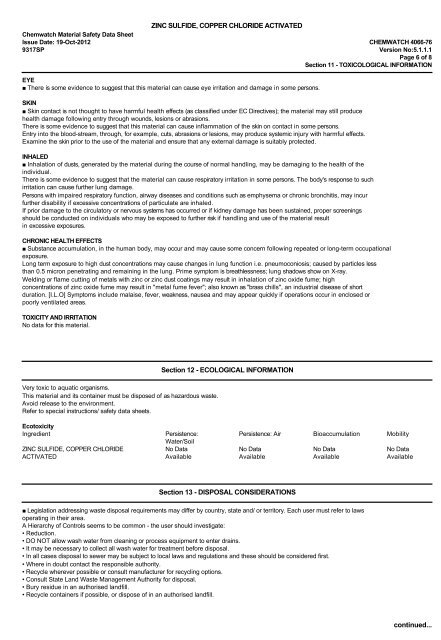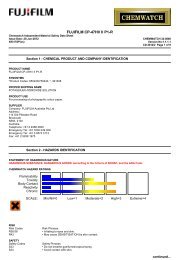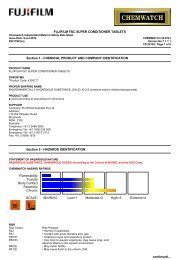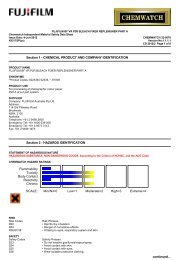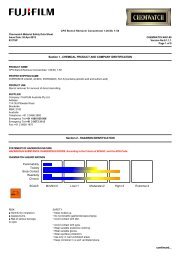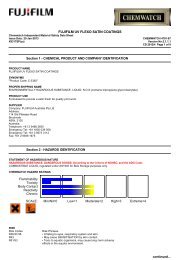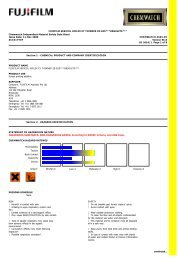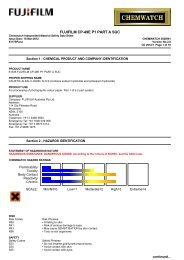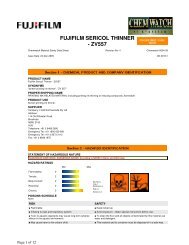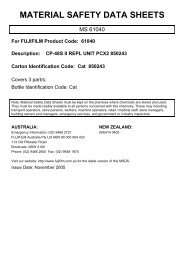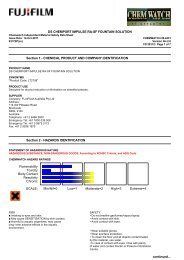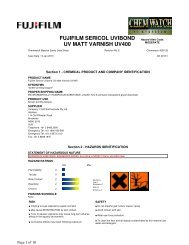Chemwatch MSDS Print - FUJIFILM Australia
Chemwatch MSDS Print - FUJIFILM Australia
Chemwatch MSDS Print - FUJIFILM Australia
You also want an ePaper? Increase the reach of your titles
YUMPU automatically turns print PDFs into web optimized ePapers that Google loves.
ZINC SULFIDE, COPPER CHLORIDE ACTIVATED<br />
<strong>Chemwatch</strong> Material Safety Data Sheet<br />
Issue Date: 19-Oct-2012 CHEMWATCH 4066-76<br />
9317SP<br />
Version No:5.1.1.1<br />
Page 6 of 8<br />
Section 11 - TOXICOLOGICAL INFORMATION<br />
EYE<br />
■ There is some evidence to suggest that this material can cause eye irritation and damage in some persons.<br />
SKIN<br />
■ Skin contact is not thought to have harmful health effects (as classified under EC Directives); the material may still produce<br />
health damage following entry through wounds, lesions or abrasions.<br />
There is some evidence to suggest that this material can cause inflammation of the skin on contact in some persons.<br />
Entry into the blood-stream, through, for example, cuts, abrasions or lesions, may produce systemic injury with harmful effects.<br />
Examine the skin prior to the use of the material and ensure that any external damage is suitably protected.<br />
INHALED<br />
■ Inhalation of dusts, generated by the material during the course of normal handling, may be damaging to the health of the<br />
individual.<br />
There is some evidence to suggest that the material can cause respiratory irritation in some persons. The body's response to such<br />
irritation can cause further lung damage.<br />
Persons with impaired respiratory function, airway diseases and conditions such as emphysema or chronic bronchitis, may incur<br />
further disability if excessive concentrations of particulate are inhaled.<br />
If prior damage to the circulatory or nervous systems has occurred or if kidney damage has been sustained, proper screenings<br />
should be conducted on individuals who may be exposed to further risk if handling and use of the material result<br />
in excessive exposures.<br />
CHRONIC HEALTH EFFECTS<br />
■ Substance accumulation, in the human body, may occur and may cause some concern following repeated or long-term occupational<br />
exposure.<br />
Long term exposure to high dust concentrations may cause changes in lung function i.e. pneumoconiosis; caused by particles less<br />
than 0.5 micron penetrating and remaining in the lung. Prime symptom is breathlessness; lung shadows show on X-ray.<br />
Welding or flame cutting of metals with zinc or zinc dust coatings may result in inhalation of zinc oxide fume; high<br />
concentrations of zinc oxide fume may result in "metal fume fever"; also known as "brass chills", an industrial disease of short<br />
duration. [I.L.O] Symptoms include malaise, fever, weakness, nausea and may appear quickly if operations occur in enclosed or<br />
poorly ventilated areas.<br />
TOXICITY AND IRRITATION<br />
No data for this material.<br />
Section 12 - ECOLOGICAL INFORMATION<br />
Very toxic to aquatic organisms.<br />
This material and its container must be disposed of as hazardous waste.<br />
Avoid release to the environment.<br />
Refer to special instructions/ safety data sheets.<br />
Ecotoxicity<br />
Ingredient Persistence: Persistence: Air Bioaccumulation Mobility<br />
Water/Soil<br />
ZINC SULFIDE, COPPER CHLORIDE No Data No Data No Data No Data<br />
ACTIVATED Available Available Available Available<br />
Section 13 - DISPOSAL CONSIDERATIONS<br />
■ Legislation addressing waste disposal requirements may differ by country, state and/ or territory. Each user must refer to laws<br />
operating in their area.<br />
A Hierarchy of Controls seems to be common - the user should investigate:<br />
• Reduction.<br />
• DO NOT allow wash water from cleaning or process equipment to enter drains.<br />
• It may be necessary to collect all wash water for treatment before disposal.<br />
• In all cases disposal to sewer may be subject to local laws and regulations and these should be considered first.<br />
• Where in doubt contact the responsible authority.<br />
• Recycle wherever possible or consult manufacturer for recycling options.<br />
• Consult State Land Waste Management Authority for disposal.<br />
• Bury residue in an authorised landfill.<br />
• Recycle containers if possible, or dispose of in an authorised landfill.<br />
continued...


